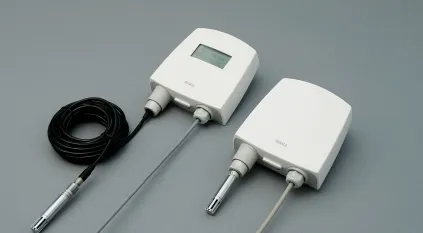
What is Dew Point?
Dew point is the atmospheric temperature (varying according to pressure and humidity) below which water droplets begin to condense and dew (tiny drops of water that) can form. When air has reached the dew-point temperature at a particular pressure, the water vapor in the air is in equilibrium with liquid water, meaning water vapor is condensing at the same rate at which liquid water is evaporating.
Why Measure Dew Point?
Measuring dew point is important because condensation in pressurized air is problematic, as it causes blockages in pipes, machinery breakdowns, contamination, and freezing. By using dew point measurement over-drying can be avoided and energy savings for equipment become notable. Therefore, the savings of measuring dew point outweigh the costs of not measuring dew
point.
How Does it Work?
There are three common types of sensors for dew point measurement: chilled mirrors, metal oxide, and polymer sensors.
Capacitive Metal Oxide – They have built in a layered structure sandwiching together a substrate base layer, a lower electrode, a hygroscopic metal-oxide middle layer, and a water permeable upper electrode. The capacitance across the upper and lower electrode changes base d on the amount of water vapor absorbed by the metal oxide layer (the dielectric of the capacitor), which is a function of dew point.
Pros: Lowest dew point measurement of -100°C
Cons: Poor long-term stability, dew points various at higher ranges, and is easily damaged by high humidity levels.
Capacitive Polymer Sensors – Very similar to the capacitive metal oxide sensor, but polymer sensors do not have a hygroscopic layer. The polymer sensor is bonded together with a resistive temperature sensor. The polymer sensor measures the humidity (amount of water molecules in the measured gas) in terms of relative humidity while the temperature sensor measures the temperature of the polymer sensor. From these two values, the microprocessor in the transmitter electronics calculates the dew point temperature. An auto-calibration feature is used to measure accurate dew point values. When relative humidity approaches zero, small changes in humidity will result in quite large changes in the dew point readings. During auto-calibration, the sensor is heated and allowed to cool while the humidity is monitored. Readings of the sensor are monitored and plotted. The data is then analyzed and used to adjust the reading of the sensor.
Pros: Can measure accurately over a wide humidity range and in numerous applications and requires minimal maintenance.
Chilled Mirrors – the operating principle is based on the fundamental definition of dew point, which is the cooling of a volume of air until condensation forms. A gas sample passes over a metallic mirror surface which is chilled by a cooler. Light is then directed at the mirror allowing an optical sensor to measure the amount of reflected light. When the mirror is cool to the point at which condensation can form on its surface (i.e. the dew point has been reached), the amount of light reflected by the mirror diminishes. The rate of cooling is then carefully regulated by a temperature sensor on the mirror. Once a state of equilibrium has been reached between the rate of evaporation and condensation, the mirror temperature is equal to the dew point.
Pros: The highest accuracy of all options over a wide range of dew points.
Cons: The sensor is expensive, highly sensitive to dirt, oil, dust, and other contaminants, and needs frequent cleaning and maintenance.
Comments are closed